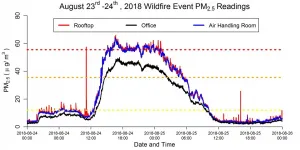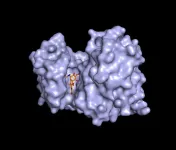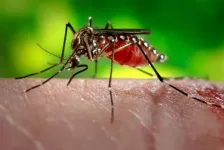(Press-News.org) Just when you thought you could head indoors to be safe from the air pollution that plagues the Salt Lake Valley, new research shows that elevated air pollution events, like horror movie villains, claw their way into indoor spaces. The research, conducted in conjunction with the Utah Division of Facilities Construction and Management, is published in Science of the Total Environment.
In a long-term study in a Salt Lake-area building, researchers found that the amount of air pollution that comes indoors depends on the type of outdoor pollution. Wildfires, fireworks and wintertime inversions all affect indoor air to different degrees, says Daniel Mendoza, a research assistant professor in the Department of Atmospheric Sciences and visiting assistant professor in the Department of City & Metropolitan Planning. The study is unique, Mendoza says, combining a long-term indoor air quality monitoring project with paired outdoor measurements and research-grade instruments.
"We all know about the inversions," Mendoza says. "We all know how large of a problem wildfires are. But do we really know what happens when we're inside?"
The setup
Mendoza, who also holds appointments as an adjunct assistant professor in the Pulmonary Division at the School of Medicine and as a senior scientist at the NEXUS Institute, and his colleagues set up their air monitoring equipment at the Unified State Laboratories in Taylorsville, Utah. They placed three sensors to measure airborne concentrations of particulate matter: One on the roof to measure outdoor air, one in the air handling room--where the outdoor air comes in--and one in an office. The building uses a 100% outside air filtration system; this is not typical for most commercial buildings, which usually use some amount of recirculated air.
The sensors stayed in place from April 2018 to May 2019, just over a year. In the Salt Lake Valley, a year's air quality events include fireworks-laden holidays on Independence Day and Pioneer Day (July 24), smoke from wildfires throughout the West that settles in the bowl-like valley and wintertime inversions in which the whole valley's emissions are trapped in a pool of cold air.
Through it all, the team's sensors kept watch. Amid the expected events, however, a private fireworks show took place on Aug. 17, 2018, within five miles of the study building, providing an unexpected research opportunity. More on that later.
Inversions
Minute-by-minute outdoor and indoor air particulate matter measurements during a December 2018 inversion.
During a wintertime inversion event in December, as the Air Quality Index outdoors reached orange and red levels, the indoor air quality reached yellow levels and stayed there until the inversion cleared. In all, the pollution levels inside were about 30% of what they were outside.
That's not surprising, Mendoza says. During inversions, only around 20% of the air pollution is what's called primary pollution - the particulate matter that comes directly from combustion exhaust. The rest is secondary--formed as gases undergo chemical reactions under specific meteorological conditions and combine to form solid particulates. As soon as the air comes indoors, those meteorological conditions change.
"That changes the chemical environment for these particles and they actually dissociate," Mendoza says. "That's what we're suspecting is happening when these particles come into the building and that's why we don't observe them."
Wildfires
Minute-by-minute outdoor and indoor air particulate matter measurements during an August 2018 wildfire event.
In late August 2018, when three active wildfires were burning in California, indoor air pollution rose to about 78% of outside pollution levels.
"For nearly 48 hours," the researchers wrote, "indoor air quality reached levels considered problematic for health compromised populations and nearly reached levels considered unsafe for all populations."
It's important to note, though, that thanks to the building's air handling system, the air is still safer inside than outside.
The reason for the higher infiltration of particulate matter, Mendoza says, is that smoke particles are stable and don't break down in different temperature and humidity conditions.
"We see those particles travel straight through the system," Mendoza says, "because there's no specific filtration that blocks out these particles. Smoke particles can also be smaller in size; that's why they're so dangerous for us."
Fireworks
Minute-by-minute outdoor and indoor air particulate matter measurements during the 2018 Independence Day holiday.
Utah has two major fireworks holidays: July 4 and July 24 (Pioneer Day). But the researchers happened to catch a signal from a private fireworks event just a few weeks before the wildfire smoke event, providing an opportunity to see how fireworks shows, both large and small, affected indoor air quality.
The smoke from fireworks is somewhere between inversion pollution and wildfires. It contains primary smoke particles as well as the gases that can combine to produce secondary particulates, which can come from the chemicals used to produce fireworks' bright colors.
On the night of July 4, 2018, air quality sharply deteriorated once fireworks shows began and stayed in the red range, with spikes into the purple "very unhealthy" range, for about three hours. Indoor air quality reached orange levels, registering about 30% of the outdoor air pollution.
"It was only after 8 a.m. on July 5 that indoor air quality returned to pre-fireworks levels," the researchers write.
Minute-by-minute outdoor and indoor air particulate matter measurements during a private fireworks event.
The private fireworks show on August 17 lasted only 30 minutes, and although the scope was much smaller, the smoke was still enough to raise the indoor air quality index to orange for several minutes.
"Even a 'small' fireworks show did have a marked impact on indoor air quality," Mendoza says. That matters to people with respiratory challenges who can see large-scale, poor air quality events like inversions and fireworks holidays coming--but who might find private fireworks shows an unpleasant surprise.
The commercial building that the researchers studied is a somewhat controlled environment. Learning about indoor air quality in homes will be a greater challenge. "You have kids coming in with mud or with dirt on their feet, you have vacuuming and cooking. So that's going to be our next step." As many people are spending more time at home due to the COVID-19 pandemic, the research will hopefully help understand what actions people can take to improve their indoor air quality.
"There is a lot of opportunity to reduce the pollutants that reach occupants in buildings, both commercial and residential," says Sarah Boll, assistant director of the Utah Division of Facilities Construction and Management. "To me, that is the great part of this work--with more research it can point the way to protecting people indoors."
INFORMATION:
Find the full study here.
Tabitha Benney, associate professor of political science, was a co-author of this manuscript, along with Mendoza and Boll.
Researchers Learn that Pregnant Women Pass Along Protective COVID Antibodies to their Babies
Antibodies that guard against COVID-19 can transfer from mothers to babies while in the womb, according to a new study from Weill Cornell Medicine and NewYork-Presbyterian researchers published in the American Journal of Obstetrics and Gynecology.
This discovery, published Jan. 22, adds to growing evidence that suggests that pregnant women who generate protective antibodies after contracting the coronavirus often convey some of that natural immunity to their fetuses. The findings also lend support to the idea that vaccinating mothers-to-be may also have benefits for their newborns.
"Since we can now say that the antibodies pregnant women make against COVID-19 ...
The U.S. pulp and paper industry uses large quantities of water to produce cellulose pulp from trees. The water leaving the pulping process contains a number of organic byproducts and inorganic chemicals. To reuse the water and the chemicals, paper mills rely on steam-fed evaporators that boil up the water and separate it from the chemicals.
Water separation by evaporators is effective but uses large amounts of energy. That's significant given that the United States currently is the world's second-largest producer of paper and paperboard. The country's approximately 100 paper mills are estimated to use about 0.2 quads (a quad is a quadrillion BTUs) of energy per year for water recycling, making it one of the most energy-intensive chemical processes. All industrial ...
Large galaxies are known to strip the gas that occupies the space between the stars of smaller satellite galaxies.
In research published today, astronomers have discovered that these small satellite galaxies also contain less 'molecular' gas at their centres.
Molecular gas is found in giant clouds in the centres of galaxies and is the building material for new stars. Large galaxies are therefore stealing the material that their smaller counterparts need to form new stars.
Lead author Dr Adam Stevens is an astrophysicist based at UWA working for the International Centre for Radio Astronomy Research (ICRAR) and affiliated to the ARC Centre of Excellence in All Sky Astrophysics in 3 Dimensions (ASTRO 3D).
Dr Stevens ...
FAYETTEVILLE, Ark. - Cold temperatures, prevalent during glacial periods, had a significant impact on past and modern unglaciated landscapes across much of North America, according to a recent study by University of Arkansas geologist Jill A. Marshall.
Marshall, assistant professor of geosciences, is the first author of the study, published in the journal Geophysical Research Letters.
The findings help shape understanding of the earth's "Critical Zone," the relatively thin layer of the planet that extends from where vegetation meets the atmosphere to the lowermost extent of weathered bedrock. "Climate and ecosystems determine how quickly bedrock ...
DALLAS - Feb. 22, 2021 - Three decades-old antibiotics administered together can block a type of pain triggered by nerve damage in an animal model, UT Southwestern researchers report. The finding, published online today in PNAS, could offer an alternative to opioid-based painkillers, addictive prescription medications that are responsible for an epidemic of abuse in the U.S.
Over 100 million Americans are affected by chronic pain, and a quarter of these experience pain on a daily basis, a burden that costs an estimated $600 billion in lost wages and medical expenses ...
Scientists have identified a way to "rescue" muscle cells that have genetically mutated, paving the way to a possible new treatment for rare childhood illness such as Duchenne Muscular Dystrophy (DMD).
The study, led by the Universities of Exeter and Nottingham, is published in the Proceedings of the National Academies of Sciences, USA. The research used novel drugs being developed at the University of Exeter, which "metabolically reprogram" the cellular energy production centres in muscle cells, by providing them with a fuel source to generate metabolic energy.
DMD is a genetic condition caused by a mutation in a gene called dystrophin which results in progressive irreversible muscular degeneration and weakening. Its symptoms include muscle ...
Things just got hairy at Princeton.
Researchers found they could coat a liquid elastic on the outside of a disc and spin it to form useful, complex patterns. When spun just right, tiny spindles rise from the material as it cures. The spindles grow as the disc accelerates, forming a soft solid that resembles hairs.
Inspired by biological designs and rationalized with mathematical precision, the new method could be used at an industrial scale for production with plastics, glasses, metals and smart materials.
The researchers published their findings ...
(Boston)--Tau is a protein that helps stabilize the internal skeleton of nerve cells (neurons) in the brain. Groups of toxic tau protein, termed tau oligomers, drive disease progression and memory loss in Alzheimer's disease (AD). A new study from Boston University School of Medicine (BUSM) shows how these tau oligomers form, and, correspondingly, how they can be prevented.
AD is a major cause of disease in the elderly and places a huge financial cost on the health care system. Scientists have known for a long time that two proteins (?-amyloid and tau) clump and accumulate in the brains ...
LOGAN, UTAH, USA -- You might not like mosquitoes, but they like you, says Utah State University biologist Norah Saarman. And where you lead, they will follow.
In addition to annoying bites and buzzing, some mosquitoes carry harmful diseases. Aedes aegypti, the so-called Yellow Fever mosquito and the subject of a recent study by Saarman and colleagues, is the primary vector for transmission of viruses causing dengue fever, chikungunya and Zika, as well as yellow fever, in humans.
"Aedes aegypti is an invasive species to North America that's become widespread in the eastern United States," says Saarman, assistant professor in USU's Department of Biology and the USU Ecology Center, whose research focuses ...
Adolescents and teens may be more likely to be bullied by their friends -- and friends-of-friends -- than classmates they don't know as well, according to a new study.
Diane Felmlee, Distinguished Professor of Sociology and Demography at Penn State and researcher on the paper, said the findings give new insight into how and why bullying occurs -- important information for anti-bullying efforts.
"People often assume that bullying occurs between relative strangers, or that it targets those on the fringes of the social network," Felmlee said. "Those do occur, but in our study, we find that the rate of peer aggression is significantly higher between those students who are closely linked. Furthermore, our finding is not due to friends simply spending ...





